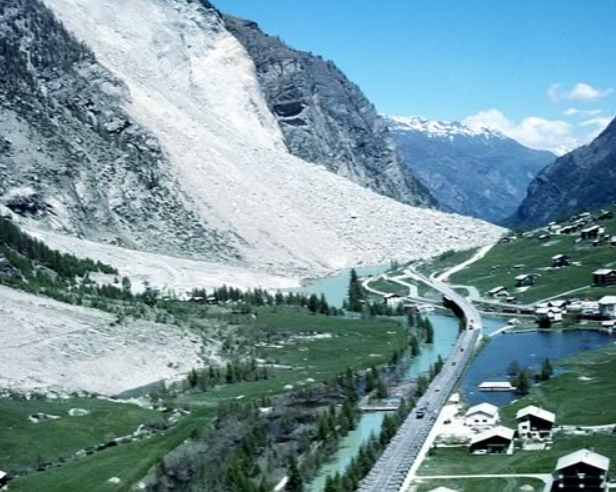21 March 2014
The Randa rockslide – a spectacular new video
Posted by Dave Petley
The Randa Rockslide
The Randa rockslide in Switzerland is probably one of the best known and most intensively investigated landslides in the world – so well known that it even has its own wikipedia page! The main action occurred in two collapse events in April and May 1991:
..
The Wikipedia page summarises the events well:
The 1991 rockslides at Randa consisted of two separate collapse events on April 18 and May 9, which released in total a cumulative volume of approximately 30 million cubic meters of rock. The elevation of the top of the scarp is 2320 m (7610 ft), while the elevation of deposit toe is 1320 m (4330 ft).
Accelerating occurrences of small rockfalls from the cliff in the decades preceding the slides gave indication of deeper movements, and fallen debris had eventually destroyed much of the forest beneath the cliff (Sartori et al., 2003). Precursory events noted immediately prior to the April, 1991 rockslide included explosive ruptures of rock slabs and new forceful water discharges from the face (Schindler et al., 1993).
April 18, 1991: This primary rockslide event occurred over the span of a few hours time, producing a large steep debris cone and a thick layer of dust over the valley. The rockslide consisted of a progressive succession of smaller collapses and block failures involving first the lower and more competent orthogneiss, followed by retrogressive collapse of the highly-jointed paragneiss above (Schindler et al., 1993). The total volume released during this rockslide phase was estimated to be 22 million cubic meters. Had this volume been released instantaneously, a devastating rock avalanche and far reaching deposit would have resulted. A lesser failure followed on April 22.
May 9, 1991: Monitoring of deformation and microseismic activity led to accurate anticipation of this follow up rockslide event. The rockslide again occurred in a progressive manner over the course of a few hours, involving many small volume collapse events mostly within the upper paragneiss material (Schindler et al., 1993). These failures resulted in retreat and reduced the inclination of the upper part of the rockslide scarp. The total volume released in this second phase was estimated to be 7 million cubic meters.
No one trigger can be conclusively assigned as responsible for the Randa rockslides of 1991. The area has experienced a long history of moderate seismicity, but no significant earthquakes immediately preceded the failures. A warm period producing ample snow melt occurred in the days prior to the April rockslide, and water could be seen emanating from springs on the rock face. Further, a period of rapid cooling occurred just one day before the April slide. However, it is unknown if this series of events combined to act as an exceptional trigger, or if they were rather part of the normal seasonal climatic and hydraulic cycles (Sartori et al., 2003).
Since the 1991 failures, the site of the rockslide has been investigated in detail by the brilliant Engineering Geology team at ETH led by Simon Loew.
A video of the April 1991 Randa landslide
The reason for posting this is that a new video has appeared on Youtube that shows the 1991 collapse event as it occurred. The quality of the video is not so good, but the content is truly amazing:
..
..
This illustrates beautifully the retrogressive nature of this type of collapse (i.e. it occurs sequentially rather than all in one go), and the way that a collapse on this scale means that the debris starts to behave in a way that at least superficially looks like a fluid.



 Dave Petley is the Vice-Chancellor of the University of Hull in the United Kingdom. His blog provides commentary and analysis of landslide events occurring worldwide, including the landslides themselves, latest research, and conferences and meetings.
Dave Petley is the Vice-Chancellor of the University of Hull in the United Kingdom. His blog provides commentary and analysis of landslide events occurring worldwide, including the landslides themselves, latest research, and conferences and meetings.